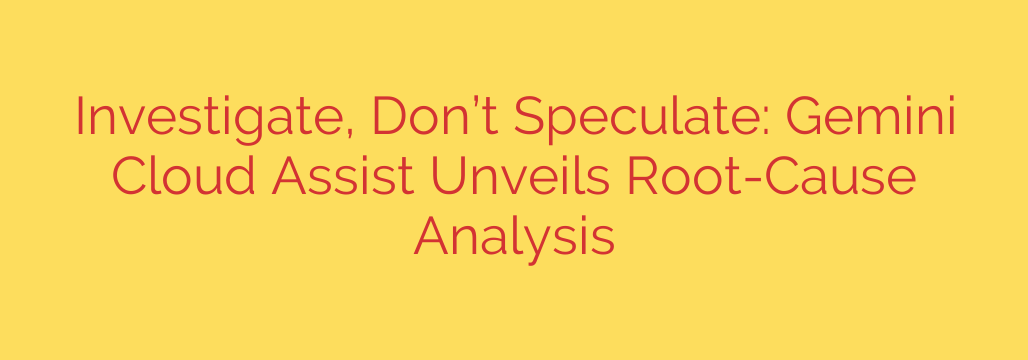
Revolutionizing Cloud Troubleshooting: How AI is Automating Root-Cause Analysis
The dreaded 3 AM pager alert. For any DevOps or Site Reliability Engineer (SRE), it’s the start of a high-stakes race against the clock. A critical service is down, customers are impacted, and the pressure is on to find the cause—fast. The traditional process is a frantic scramble through endless dashboards, logs, and metrics, a hunt for the digital needle in a haystack. This manual effort is not only stressful but also costly, as every minute of downtime impacts revenue and reputation.
However, the era of speculative troubleshooting is coming to an end. A new wave of generative AI-powered tools is fundamentally changing how we approach incident management. By shifting the paradigm from manual searching to automated investigation, these systems promise to drastically reduce downtime and free up engineering talent for more valuable work.
The Old Way: The Pitfalls of Manual Investigation
In complex, modern cloud environments built on microservices, identifying the root cause of a problem is incredibly challenging. An issue in one service can cascade, creating alerts and symptoms in dozens of others. Engineers are often forced to speculate based on gut feelings and past experiences, asking questions like:
- Was it the last code deployment?
- Is the database overloaded?
- Did a cloud provider have an outage?
This process is slow, inefficient, and prone to human error. Teams waste precious time chasing dead ends while the Mean Time to Resolution (MTTR) ticks ever higher. The core problem is a lack of context; the data is all there, but connecting the dots across disparate systems in real-time is a monumental task.
A New Approach: Investigate, Don’t Speculate
The latest advancements in AI offer a powerful solution. Instead of requiring engineers to manually sift through data, new AI assistants can ingest and correlate massive volumes of observability data—including logs, metrics, traces, and code changes—from across your entire cloud infrastructure.
By analyzing this comprehensive dataset in real-time, these AI tools can identify the most likely cause of an incident automatically. The focus moves from speculation to data-driven investigation. The primary goal is to provide a clear, concise, and actionable summary of what went wrong, allowing teams to resolve the issue immediately.
Key Capabilities of AI-Driven Root-Cause Analysis
This new technology isn’t just about finding problems faster; it’s about providing deeper, more contextual insights that were previously impossible to achieve at scale.
- Automated Data Correlation: At its core, the AI assistant excels at finding patterns. It can instantly connect a spike in server latency with a specific error log, a recent code deployment, and a change in user traffic. This eliminates the need for an engineer to have multiple dashboards open while trying to manually correlate timelines.
- Natural Language Summaries: Perhaps the most significant breakthrough is the output. Instead of presenting raw data, the system provides a simple, human-readable summary of the incident. An engineer might receive a clear statement like: “The checkout service is failing due to a database connection pool exhaustion, which began immediately after the ‘v2.1.5’ deployment.”
- Accelerated Incident Resolution: By pointing directly to the problem, AI-powered analysis drastically cuts down on the investigation phase of an incident. This directly lowers MTTR, minimizes the impact of outages, and reduces the stress on on-call engineers. The system can also suggest remediation steps, further speeding up the recovery process.
Actionable Tips for Preparing Your Team
Adopting AI for incident management is more than just flipping a switch. To get the most out of these powerful tools, engineering teams should focus on building a strong foundation.
- Centralize Your Observability Data: An AI is only as smart as the data it can access. Ensure that your logs, metrics, and traces are standardized and collected in a central location. A robust observability platform is the bedrock of effective AI-powered analysis.
- Improve Alerting Quality: “Alert fatigue” is a major problem that hinders effective incident response. Work on refining your alerting rules to reduce noise. High-quality, meaningful alerts provide cleaner signals for an AI to analyze, leading to more accurate conclusions.
- Embrace a Culture of Automation: Encourage your team to automate routine tasks within your incident response workflow. The more your processes are automated, the easier it will be to integrate an AI assistant to handle the complex analytical work.
The future of cloud operations is here, and it’s powered by intelligent automation. By leveraging AI to perform root-cause analysis, organizations can build more resilient systems, empower their engineers to solve problems faster, and ultimately deliver a more reliable experience to their users. It’s time to move beyond the high-stress guesswork and into an era of swift, data-driven investigation.
Source: https://cloud.google.com/blog/products/management-tools/gemini-cloud-assist-investigations-performs-root-cause-analysis/








